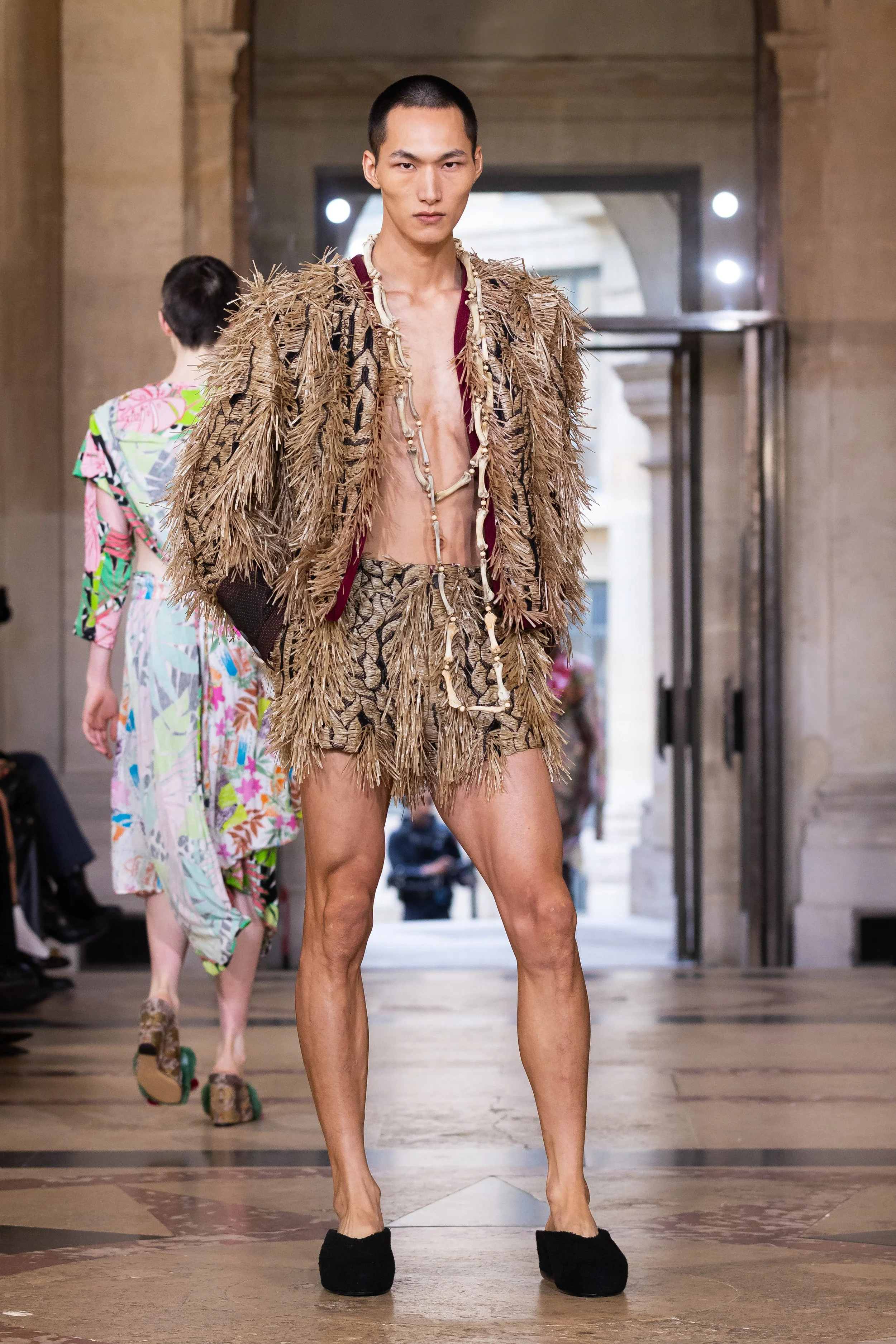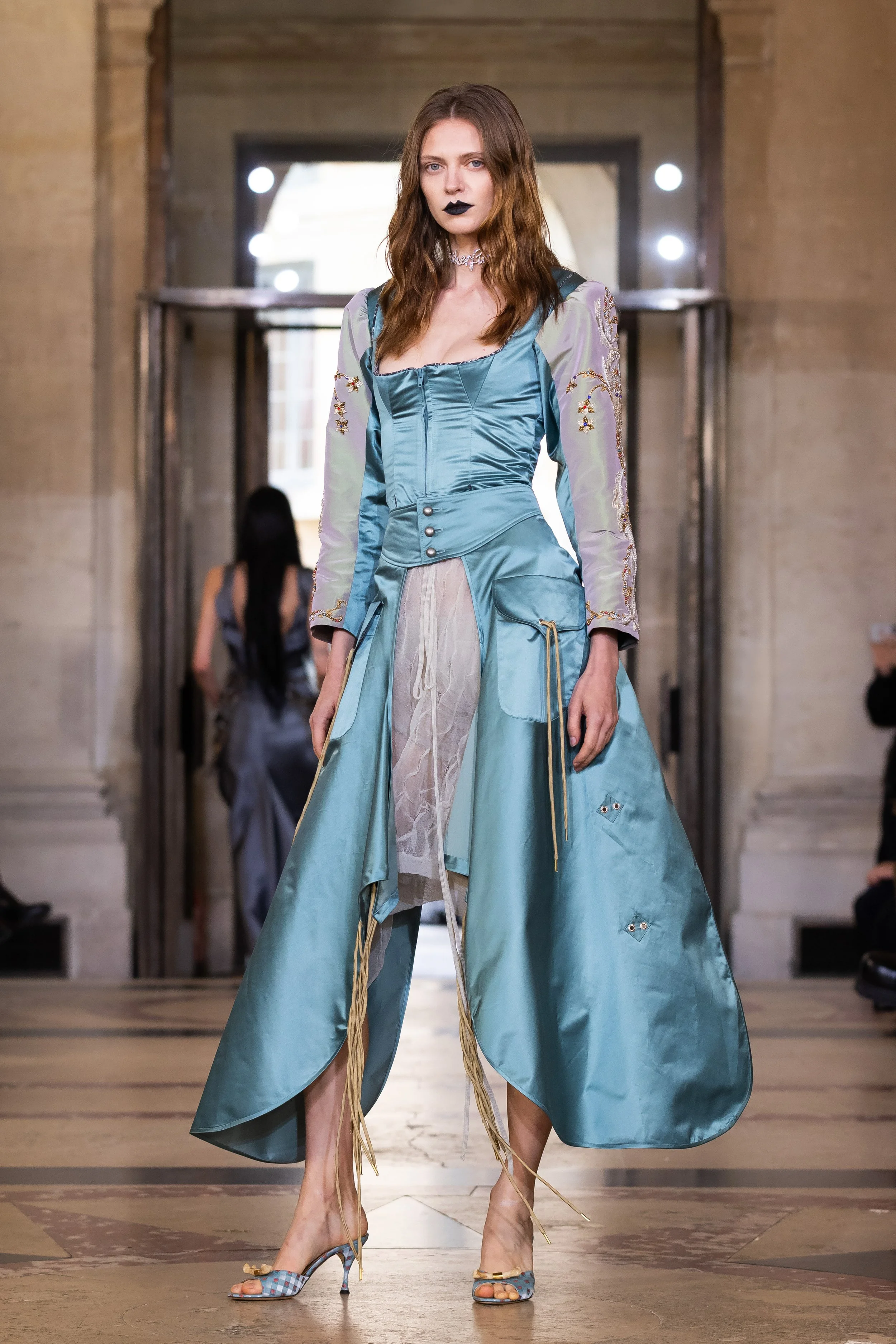PARIS FASHION WEEK SPRING/SUMMER 2026: DAY 6
editors ELIANA CASA, MAREK BARTEK, MARIA MOTA and MARIE-PAULINE CESARI
ALAÏA
review by MAREK BARTEK
all images ALAÏA via vogue.com
At Alaïa, Pieter Mulier turned introspection into a mesmerising experience. “In the world that we live in now… I wanted you guys to feel you were in a cocoon for 10 minutes—this thing of an absolute dream—but still with a tension,” he shared backstage, adding, “I wanted clothes that cry,” — and somehow, they did. The space itself shimmered like a dream: faces projected across the floor and ceiling, shifting into body scans that pulsed in rhythm with the models’ steps. The effect was hypnotic. Not showy but intimate. It was truly a digital spectacle framing what was a deeply emotional collection.
It opened with simplicity: stark cotton tunics cut close to the body, a nod to an archival coat Azzedine once made for himself. Reverent but not nostalgic, modern in its modesty, they were styled with stockings from the tops of which cascaded silk fringes. What followed traced the line between sensuality and sculpture: seamless silk knits hugging the frame like liquid architecture; hybrids of armless top-leggings or open sided skirt-trousers. If Mulier’s early Alaïa was about power and body-con, this felt gentler, grown-up, and human. Coats unfolded into fluid, almost weightless forms; satin gowns at the end carried a whisper of the 18th century, rendered with startling precision.
More than a return to form, this was a reckoning. A reminder that beauty and vulnerability can coexist. Mulier doesn’t design for virality or shock. He builds atmospheres, emotions, entire worlds of touch and tension. In a moment when so much of fashion feels engineered for clicks, Alaïa still feels handcrafted — not just in technique, but in spirit.
MAISON MARGIELA
review by NIA TOPALOVA
all images MAISON MARGIELA via vogue.com
Glenn Martens just presented his first ready-to-wear collection for Margiela following his Artisanal debut, and boy, did he deliver. The show opened in the most precious and unexpected way – with an orchestra of 61 children performing Stanley Kubrick’s “2001: A Space Odyssey”, Bizet’s “Carmen”, Tchaikovsky’s “Swan Lake”, and Sergei Prokofiev’s “Dance of the Knights”. Charmingly disregarding precision or care for the right notes, the kids really seemed like they’re having the time of their lives.
Giving the stage to kids and letting them take over was a reference to Margiela’s Spring 1990’s “playground” show, where the models, having intentionally missed the last couple of months' hair appointments, as desired by Martin himself, walked on heels in the mud, surrounded by the children, walking with them on their shoulders. All this served as a reminder of human purity, how simple everything could be, and how beauty often can be found exactly in the dirt and the flaws.
The Spring 2026 collection featured reworked tailoring with rounded shoulders, “plasticised” jewellery and garments, elongated silhouettes, draped and layered trenches. There were vintage lingerie slips, upcycled jewellery, worn-in leather jackets and floral gowns (some of which were scanned from real flowers), and a lot of bleached denim. Martens continued the headpiece theme from his couture debut, only this time Margiela’s four corner stitches were recreated into quite disturbing mouthpieces holding the models’ mouths wide open. A soft leather box bag with reinforced sides was introduced, as well as an evolution of the Artisanal Tabi Claw and the Heel-less Boot.
What we witnessed this season were both Glenn's new design propositions and re-introductions of the archive. “Proposals for real life” delivered a finely balanced mix of what Glenn is, and what Martin was.
HERMÈS
review by MAREK BARTEK
all images HERMÈS provided by the brand, photographed by FILIPPO FIOR
Hermès headed south this season, to the wild plains of Camargue, where horses, bulls, and wind rule over elegance. “I wanted to give a spirit of freedom, of letting go, of bohemianism,” said Nadège Vanhée backstage, reimagining the equestrian codes of Hermès through a freer, more sensual lens.
Corsetry became her language of liberation: not lace and boning, but leather harnesses styled over bandeaus, shirts, and quilted silk-twill jackets in desert tones of sand, rust, and olive. The effect was both pragmatic and erotic — the horsewoman meets the city flâneur. Quilting, borrowed from the structure of a saddle, appeared across everything from pencil skirts to impeccable leather coats. There was skin, too — not to be paraded but rather used as texture. “I wanted the language of skin in the collection,” Vanhée said. Between the earthy palette, supple materials, and a new saddlebag to anchor it all, Hermès felt less tamed luxury, more elegant escape.
VIVIENNE WESTWOOD
review by NIA TOPALOVA
all images VIVIENNE WESTWOOD provided by the brand
“Does one believe in reincarnation? I can recount two previous lives. The first one being a man, a Roman soldier. The second one being the Queen of France. Now you know…”
Last night, Andreas Kronthaler presented “Boudoir” at La Coupole of L’institut de France – a place of significant cultural and historical importance, a home of the five French academies. Here, Kronthaler shared his idea of what Boudoir means to him, a sacred place where one can be as close as he wants to his senses, and even recreate itself. Kronthaler and Vivienne used to share love for the old scents of Versailles, which became the heart of “Boudoir”, both the fragrance and the collection.
After spending a proper Sicilian summer, sun-drenched and slow, Andreas came back to Paris with that same softness still on his skin, giving the collection a feeling of simplicity and ease. He used typical old Italian fabrics found at their local markets, striped linens and prints from the archives, and embroideries long forgotten in drawers. Lace-punched leather, worn-in linen, and faded floral patterns made the collection feel as if each model had stepped out of an Italian villa or a charming 17th-century oil painting. Or maybe a fever dream set between Palermo and Paris. Heidi Klum, gorgeous and glowing (as always), closed the show in a delicately embroidered laced white gown: very sexy; very Westwood.
COMME DES GARÇONS
review by MAREK BARTEK
all images COMME DES GARÇONS via vogue.com
“Believe in the positiveness and the value that can be born from the damaging of perfect things,” wrote Rei Kawakubo in her show notes — a line that could only make sense once you’d seen the collection. This was Comme des Garçons at its most raw and resolute: sculptural silhouettes, layered, frayed, and padded into strange, beautiful disarray. Kawakubo took perfection apart, both literally and conceptually. Undyed cotton shells opened like seed pods, revealing flashes of scarlet satin; coarse canvas was gathered into collapsing ruffles; white brocade and lace were interweaved with jute and horsehair. The effect was one of controlled destruction. Beauty born from distortion.
Models moved through silence, their pillow-like forms topped with distorted wigs, their clothes dense with meaning. It was less about fashion as wear, more as meditation on fragility, resistance, and the poetry of imperfection. Comme des Garçons, in its truest, most human form.
BALENCIAGA
review by MAREK BARTEK
all images BALENCIAGA provided by the brand
Pierpaolo Piccioli’s debut at Balenciaga felt like a homecoming and a rebirth all at once. Showing inside the house’s historic headquarters, the designer traded Valentino’s romanticism for something more refined — elegance stripped to essence. His point of departure? Cristóbal Balenciaga’s 1957 Sack Dress, whose radical simplicity once freed women from Dior’s corseted New Look. “He put the human at the centre,” Piccioli said. “Body, fabric, air.”
That philosophy translated into silhouettes that floated rather than fitted. The opening look — a long black V-neck gown paired with white gloves and bat-like sunglasses — set the tone: reverent yet defiant. Volume took new forms in sculptural balloon skirts, cocoon coat in absinthe green, and trapeze dress that spiralled into asymmetric hems. Crimson, magenta and chartreuse pulsed like emotion itself, proving Piccioli hasn’t abandoned beauty; he’s simply recalibrated it.
There were nods to Balenciaga’s lineage too: conceptual riding hats recalling Ghesquière, a reimagined tunic split at the neck, and tailoring softened to near-weightlessness. Even the everyday turned poetic — chinos cut with couture precision, an oversized shirt trailing into a train. Where Demna once courted irony, Piccioli offered sincerity. His Balenciaga is one of optimism, grace, and human scale, reminding us that simplicity, when done with right, can feel radical again.
ANN DEMEULEMEESTER
review by PHOEBE PHOEBE GIBSON-DOUGALL
all images ANN DEMEULEMEESTER provided by the brand
If you’d told me last week that Jane Austen, Larry Bird, and Danny Sugarman would all serve as inspiration for Stefano Gallici’s SS26 collection for Ann Demeulemeester, I’m not sure I would have believed you. Or at the very least, I would have awaited Saturday’s show with nervous anticipation, unsure of what Gallici would offer. But fear not! Whilst the connection between these three figures may not be obvious, Gallici tied each influence into his collection with romantic precision. Entitled “The Solitary One: A Love Story in Rebellion”, the clothes were at once pretty and punk-tinged, athletic and gothic.
Paying homage to Demeulemeester’s avant-garde heritage, there was black leather and tailoring aplenty, co-existing alongside basketball jerseys and pink brocade. Assuming the top spot at a brand like Ann Demeulemeester was always going to be difficult, Demeulemeester’s cult-like following of purists are difficult to please at the best of times, and Gallici’s critics may not enjoy the direction in which he is steering the brand. I respectfully disagree; in my eyes Gallici’s reinterpretation is a perfect reimagining of Demeulemeester’s codes, a surprising mix of her classic Antwerp severity and his dreamy romanticism.





















